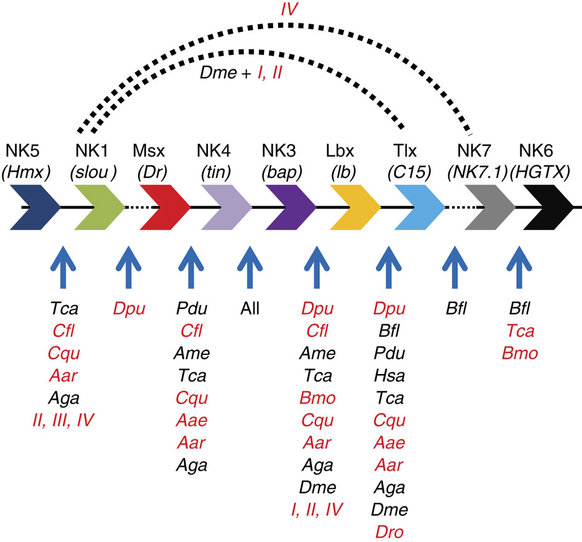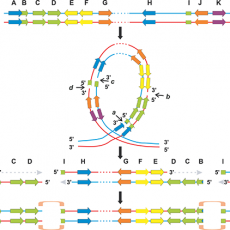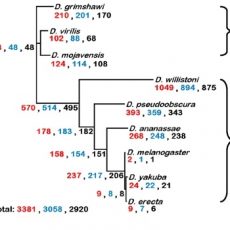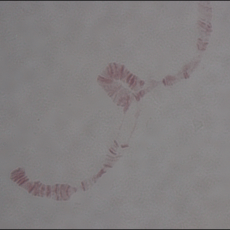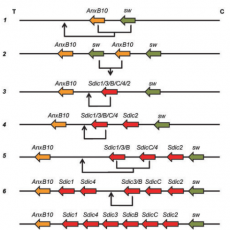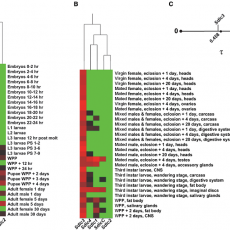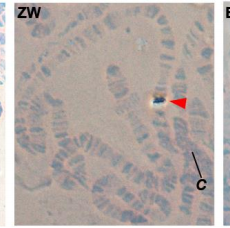Structural Evolutionary Dynamics of the Eukaryotic Genome
We are interested in exploring how large-scale chromosomal rearrangements affect the overall structure and function of eukaryotic genomes. Using comparative genomics along with molecular cytogenetic and genome editing techniques, we are addressing multiple aspects of chromosomal evolution, particularly:
- Molecular mechanisms that generate chromosomal inversions
- The relative contribution of functional and structural constraints, as opposed to chromosome fragility, to the probability of accommodating inversion breakpoints at the local level
- Molecular events that accompany gene cluster formation
- Chan, C., S. Jayasekera, B. Kao, M. Páramo, M. von Grotthuss, J.M. Ranz 2015 Remodeling of a homeobox gene cluster by multiple independent gene reunions in Drosophila. Nature Commun. 6, 6509. doi:10.1038/ncomms7509.
- Von Grotthuss, M., Ashburner, M., & J.M. Ranz 2010 Fragile regions and not functional constraints predominate in shaping gene organization in the genus Drosophila. Genome Res. 20: 1084-1096 [Cover].
- Ranz, J.M., D. Maurin, Y.S. Chan, M. von Grotthuss, L.D.W. Hillier, J. Roote, M. Ashburner, & C. Bergman 2007 Principles of genome evolution in the D. melanogaster species group. PLoS Biology 5(6): e152. doi:10.1371/journal.pbio.0050152. [Featured in Heredity 99: 479-80 (2007)]
Phenotypic Impact of Newly-Evolved Genes
Genomic regions harboring recently originated gene amplifications have been shown to be involved in species adaptation. A perfect case in point of this type of region is the Sdic multigene family, present only in Drosophila melanogaster, which has been shown to be involved in boosting male fitness through increased sperm competitive ability and is therefore acted on by sexual selection. While previous attempts at studying the mechanistic origins and evolutionary dynamics of these recently expansions have been limited by the lack of sequencing technologies with read lengths capable of resolving highly-similar, tandemly-repeated regions, as well as the difficulty of distinguishing individual copies with molecular techniques, it is only now that we are able to address key questions such as:
- How these regions evolve at the sequence and structural levels within species
- Levels of functional diversification among gene copies and their evolution
- What are the mechanisms responsible for Sdic‘s effect on sperm competition
- Clifton, B.D., P. Librado, S.D. Yeh, E. Solares, D. Real, S. Jayasekera, W. Zhang, M. Shi, R. Park, R. Magie, H.C. Ma, X.-Q. Xia, A. Marco, J. Rozas, & J.M. Ranz 2017 Rapid functional and sequence differentiation of a tandemly-repeated species-specific multigene family in Drosophila. Mol. Biol. Evol. 34: 51-65. doi: 10.1093/molbev/msw212.
- Yeh, S.-D., T. Do, C. Chan, A. Cordova, F. Carranza, E.A. Yamamoto, M. Abbassi, K.A. Gandasetiawan, P. Librado, E. Damia, P. Dimitri, J. Rozas, D.L. Hartl, J. Roote & J.M. Ranz 2012 Functional evidence that a recently evolved Drosophila sperm-specific gene boosts sperm competition. Proc. Natl. Acad. Sci. USA doi: 10.1073/pnas.1121327109.
Transcriptome Evolution
Evolution of gene expression attributes, such as expression level, breadth, and timing, are drivers of phenotypic differences both between and within species. We are interested in linking genetic differences to changes in mRNA abundance within several contrasts that are presumably in the early stages of gene regulatory evolution:
- Among populations of Anopheles mosquitoes living in different ecological regions of Burkina Faso
- Among experimental populations of Drosophila melanogaster exposed to very divergent selection regimes
- Among strains of Drosophila willistoni exhibiting evidence of reproductive isolation
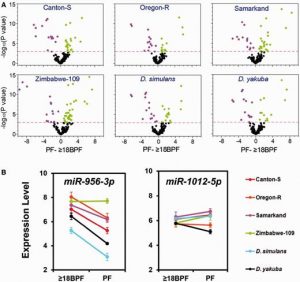
- Yeh, S.-D, M. von Grotthuss, K.A. Gandasetiawan, S. Jayasekera, X.-Q. Xia, C. Chan, V. Jayaswal, & J.M. Ranz 2014 Functional divergence of the miRNA transcriptome at the onset of Drosophila metamorphosis. Mol. Biol. Evol. 31(10): 2557-72. doi: 10.1093/molbev/msu195.
Collaborators:
Cei Abreu-Goodger, LANGEBIO
Diego Ayala, Institute de Research for Development (IRD)
Alberto Civetta, University of Winnipeg
Julio Rozas, Universitat de Barcelona
J.J. Emerson, UC Irvine
Larry Mueller, UC Irvine
Michael Rose, UC Irvine

